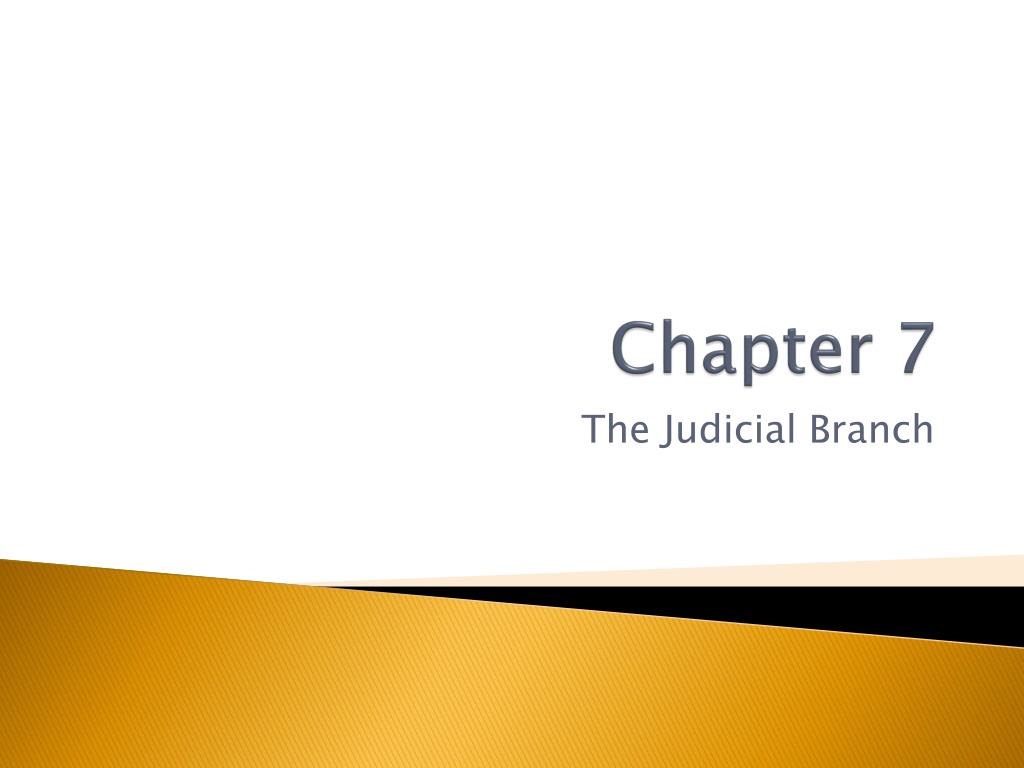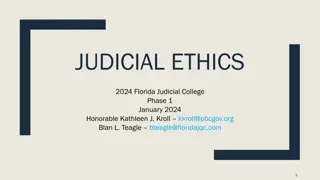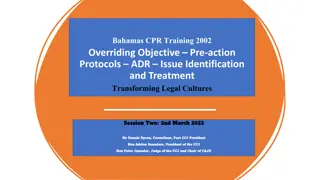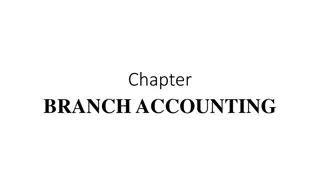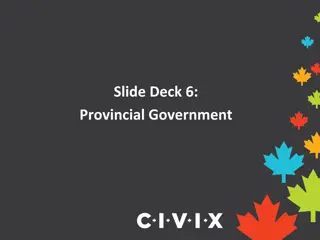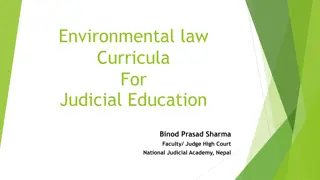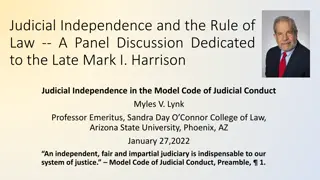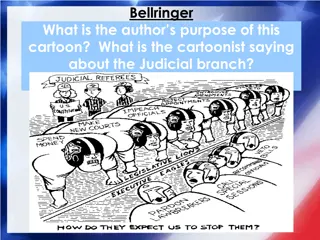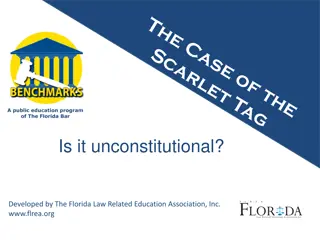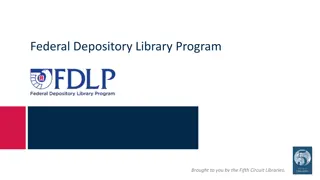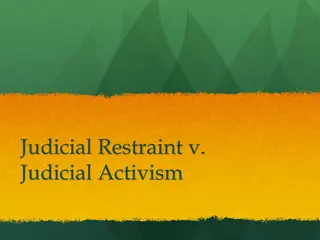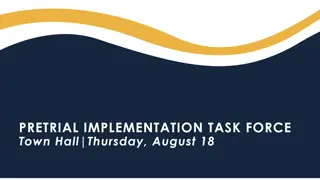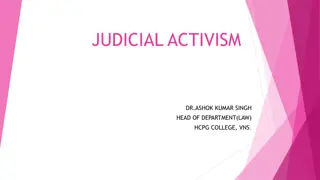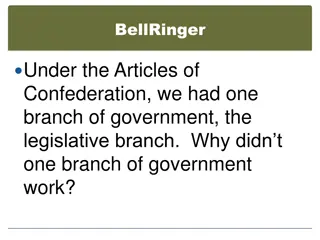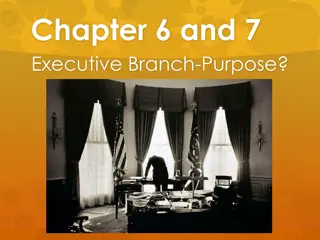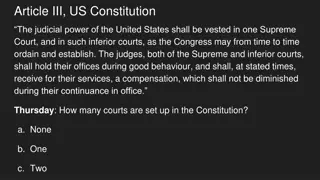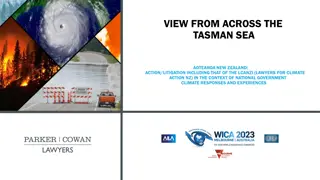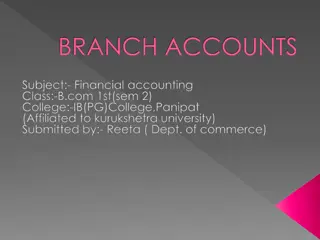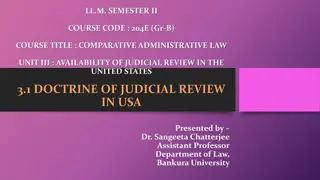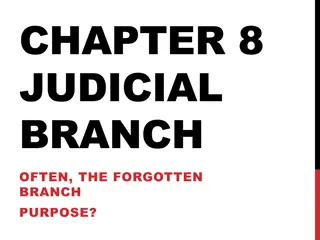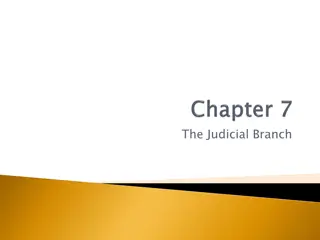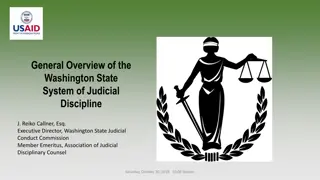Understanding the Judicial Branch of the Federal Government
The Judicial Branch, as the third branch of the federal government, ensures fair law enforcement and interprets laws through criminal and civil cases. Federal courts were established to address issues of state-based justice disparities. The judiciary system comprises district courts for trials, circuit courts for appeals, and the Supreme Court for final appeals.
Download Presentation

Please find below an Image/Link to download the presentation.
The content on the website is provided AS IS for your information and personal use only. It may not be sold, licensed, or shared on other websites without obtaining consent from the author. Download presentation by click this link. If you encounter any issues during the download, it is possible that the publisher has removed the file from their server.
E N D
Presentation Transcript
Vocabulary (4) 1. dual court system 2. jurisdiction 3. exclusive jurisdiction 4. concurrent jurisdiction
The judicial branch is the third branch of the federal government. The judicial branch's two main jobs are to make sure the laws are enforced fairly and to interpret the law. Courts hear two kinds of cases, criminal and civil. In criminal cases, people accused of crimes appear in court for trial witnesses present evidence A jury or judge decides whether the accused person is innocent or guilty
In civil cases, courts use the law to settle civil disputes. both sides come before a court. Each side lays out its view. The court applies the law to the facts that have been presented. Then it decides in favor of one side or the other. A civil dispute is a conflict between: two private parties (people, companies, or organizations) a private party and the government the U.S. government and a state or local government Federal courts decide criminal and civil cases that involve federal laws.
The power of the federal courts comes from the Constitution. Under the Articles of Confederation, the country had no national court system. Each state had its own laws and courts. Citizens were not guaranteed equal justice in all the states. To solve these problems the Founders decided to create a federal judiciary. Article III of the Constitution created a national Supreme Court. It gave Congress the power to set up a system of lower courts.
Congress set up two kinds of lower federal courts: district courts and circuit courts. District courts heard minor civil and criminal cases. They served as the trial courts for specific geographic areas. Circuit courts took more serious cases and heard appeals from the district courts. An appeal is when a person asks a higher court to review a case. In 1891, Congress made circuit courts solely courts of appeals.
The district courts at the lower level are trial courts. The circuit courts in the middle are appeals courts. The Supreme Court, the court of final appeal, is at the top. 3 Supreme Court ________________ Circuit Courts Appeals Courts _________________ 2 District Court Trial Courts 1
Each state also has laws and a court system. The state courts and federal courts exist side by side. This gives our country a dual court system. The federal courts get their powers from laws passed by Congress. The state courts get their powers from state constitutions and laws. The federal courts make sure citizens in every state are treated the same. Each person is presumed, guilty. To make sure all citizens have equal justice, the Constitution gives every accused person the right to a public trial. If the accused cannot pay for a lawyer, the court will provide one. dual court system. presumed, or thought to be, innocent until proven
Most court cases involve state laws and are tried in state courts. The Constitution gives federal courts the power to hear certain kinds of cases, however. The authority to hear and decide a case is called jurisdiction. Federal courts have jurisdiction in cases that have to do with the following: the Constitution and federal laws disputes between the states disputes between citizens of different states disputes that involve the federal government accidents or crimes that happen at sea disputes between U.S. and foreign governments jurisdiction.
In most of these areas, federal courts have exclusive jurisdiction. Only federal courts can decide on these cases. Other cases are under the state court jurisdiction. In some cases, both federal and state courts have jurisdiction. This is called concurrent jurisdiction. This occurs when a crime breaks both federal and state laws. When this happens, either court may hold a trial. exclusive jurisdiction. concurrent jurisdiction.
Vocabulary (8) 1. original jurisdiction 2. appellate jurisdiction 3. ruling 4. opinion 5. precedent 6. litigant 7. tenure 8. subpoena
The federal court system has three levels. District courts are at the lowest level. These courts have what is called original jurisdiction. This is the authority to hear cases for the first time. Most federal cases begin in a U.S. district court. There are 94 district courts. Every state has at least one. District courts hold both civil and criminal trials. Juries listen to witnesses and decide guilt or innocence based on evidence. People who lose a case in district court may appeal it to a federal appeals court. This means they can ask a higher court to review and possibly change the result of the trial. original jurisdiction.
The authority to review the fairness of a case appealed from a lower court is called appellate jurisdiction. People appeal cases for different reasons. Usually a lawyer thinks that a district court judge has made a mistake. Other times, new evidence becomes available that might have changed the original outcome of the trial. There are 12 federal appeals courts. Each court has jurisdiction over an area called a circuit. These courts are also called circuit courts of appeals. There is also a thirteenth appeals court called the Court of Appeals for the Federal Circuit. It has nationwide jurisdiction to hear special cases. These cases include patent law, international trade, and other civil cases of the U.S. government. appellate jurisdiction.
Appeals courts do not have trials. Judges make the decisions, called rulings. Three or more judges review each case. They listen to the lawyers arguments. Then they meet and vote on how to rule. They can choose to do the following: uphold, or keep the original decision made by the district court reverse the district court s decision remand the case To remand the case means to send the case back to the lower court to be tried again. rulings.
Appeals court judges do not decide guilt or innocence; rather, they rule only on whether the trial was fair. Appeals court rulings may be appealed only to the Supreme Court. When an appeals court makes a ruling, one judge writes an opinion for the court. The opinion the court s decision and is an example to be followed by other judges. Such an example is called a precedent. A precedent does not have the force of law, but it is a powerful legal argument. opinion explains the legal thinking behind precedent.
Since early in the nations history, the federal courts have followed certain guiding ideas. Judges or justices cannot decide a question of law by seeking out a lawsuit. They have to wait for litigants to file lawsuits. Litigants The principle of precedent is another guiding idea. Litigants are people involved in a lawsuit.
Federal judges make the final decisions in the federal court system. There are more than 650 federal judges in the district courts. Each district court has at least two judges. Each appeals court may have between 6 and 28 judges. The U.S. Supreme Court has nine judges, called justices.
The Constitution gives the president the power to appoint federal judges, with Senate approval. This limits the president s power. When presidents appoint judges to district courts, they follow a practice called senatorial courtesy. This means they tell the senators from the nominee s home state about their choice first. If the senators do not like the nominee, the president will usually choose a different person.
Federal judges have their jobs for life. They can be removed only through a process called impeachment. This kind of job security is called tenure. Judges who have tenure cannot be fired. This keeps them from being pressured when they have to make difficult decisions. tenure.
District courts also have magistrate judges who help judges with the workload. They do much of the routine work. They issue search and arrest warrants. They hear preliminary, decide whether a case should be tried. They may also try minor cases. preliminary, or introductory, evidence to
Each district court has a U.S. attorney. These lawyers prosecute people accused of breaking federal laws. They also represent the United States in civil cases. They are appointed by the president and approved by the Senate. Each district also has a U.S. marshal. Marshals keep order in the court. They make arrests and take convicted people to prison. They also serve, or deliver, subpoenas. A subpoena appear in court. subpoena is a court order requiring someone to
Vocabulary (3) 1. judicial review 2. constitutional 3. nullify
The United States Supreme Court is the highest court in the land. All other courts must follow its decisions. The Supreme Court has eight justices and one chief justice. The justices main job is to decide whether laws are allowed under the U.S. Constitution. The Supreme Court is also the final authority in all cases involving the Constitution, acts of Congress, and treaties with other countries.
The Supreme Court has original jurisdiction in only two kinds of cases. It can hear cases that involve diplomats from other countries. It can also hear cases that involve disputes between states. In all other cases, the Supreme Court hears appeals from lower courts. Each year thousands of cases are appealed to the Supreme Court. The justices choose the ones they will hear. After deciding a case, the Court issues a written opinion. When the Court refuses to hear a case the decision of the lower court stands.
The Constitution does not list any specific requirements for a Supreme Court justice. Before joining the Court, many justices were lawyers, educators, or lower court judges. Supreme Court justices have their jobs for life.
The Constitution gave Congress the power to decide how the Supreme Court should be organized and what its powers should be. Congress set the number of justices at nine. A key power of the Supreme Court is the power of judicial review. This is the power to review any federal, state, or local law or action to see if it is constitutional. The Court may decide that a law or action is unconstitutional. In that case the Court has the power to nullify, cancel, that law or action. judicial review. nullify, or
The Constitution did not give the Supreme Court the power of judicial review. That power came from the Judiciary Act of 1789, which gave the Supreme Court the power of judicial review over the acts of state governments. Later, the case of Marbury v. Madison in 1803 established the Court s power of judicial review over laws passed by Congress. This power gives the court a check on the other two branches of government. The other branches check the Supreme Court s power. Congress can get around a ruling by passing a new law. It can change a law that has been ruled unconstitutional. Congress and the states can also try to undo Court rulings by amending the Constitution.
The Supreme Courts power is limited in other ways as well. The Court can only hear and rule on cases that come to it through the courts. A person cannot simply ask the Supreme Court to decide if a law is constitutional. The Court will only rule on a law that has been challenged, to, on appeal. It can only take cases that concern a federal question. The Supreme Court does not have the power to enforce its rulings. It relies on the executive branch and on the states to do this. The executive branch usually enforces Supreme Court rulings, but not always. In 1832, the Supreme Court ruled in Worcester v. Georgia that the state of Georgia had to stop ignoring federal land treaties with the Cherokee Nation. President Andrew Jackson refused to enforce the ruling. Most people agreed with the president. As a result, he felt no pressure to take action. challenged, or objected
Vocabulary (8) 1. writ of certiorari 2. docket 3. caseload 4. brief 5. stare decisis 6. concurring opinion 7. dissenting opinion 8. unanimous opinion
The Supreme Court meets each year for about nine months. Each term begins the first Monday in October and ends in the summer. Sometimes special sessions are called to handle a serious matter. The Supreme Court carefully chooses the cases it will hear. The justices look for cases that raise constitutional questions. These are questions about issues such as freedom of speech, equal protection of the laws, and the right to a fair trial. The justices also look for cases that deal with real people and events. They look for cases that affect the whole country, rather than one person or group.
Almost all cases reach the Supreme Court on appeal from a lower court. Most appeals come to the Court as a petition, or request, for a writ of certiorari. A writ of certiorari records to the Supreme Court for review. The justices receive about 10,000 petitions, or requests, for writ of certiorari each term. Of these, the Court accepts 75 to 80 cases. The Court accepts a case when four of the nine justices agree to do so. The accepted cases go on the Court docket, calendar of cases to be heard. The number of cases handled in a period of time is called the caseload. writ of certiorari orders a lower court to send its case docket, or caseload.
First, the lawyers for each side in a case write a brief. A brief point of view, on the case. The two parties study each other s briefs and then give a second brief to the Court. The second brief is shorter and answers the arguments made in the first brief by the other side. Then, justices study the briefs and ask questions. Next, each side is given 30 minutes to present oral arguments before the Court. The justices then meet to make decisions about the cases. The meetings are secret. No official records are kept. At least six justices must be present to vote on a ruling. A majority vote decides a case. brief is a written document that explains one side s position, or
Justices are guided by a principle called stare decisis. In Latin this means let the decision stand. In other words, follow precedent. However, the law must also be able to change with the times. The Supreme Court has the power to overturn outdated decisions. In Brown v. Board of Education, the Court overturned an earlier decision that supported segregation laws. In that case, the Supreme Court changed its interpretation of the law to reflect changes in society. stare decisis.
When the Court has reached a decision, one justice writes the opinion for the majority stating the facts of the case and gives the ruling. The Court s written opinion sets a precedent for the lower courts to follow. Sometimes a justice agrees with the majority decision but for different reasons. They write a concurring opinion. Justices might also disagree with the majority decision. They write a dissenting opinion. Sometimes all the justices vote the same way. Then the Court issues a unanimous opinion. After the opinions are drafted comment on the draft. The justice writing the opinion takes their comments into account as he or she revises the opinion. Once the draft is final the Court announces its decision. concurring opinion. dissenting opinion. unanimous opinion. drafted, the justices review it and
